|
HINDUISM
Why I am a believer:
Hindu’s answer
Why I am a Believer, Personal Reflections on Nine World Religions,
contains nine essays by articulate believers in the Buddhist, Jaina,
Sikh, Dao, Jewish, Christian, Confucian, Muslim and Hindu faiths.
The Hindu essay, by Dr Sharma, who is also the editor of the book Why
I Am a Believer, is remarkable for its concise intellectual formulation
of Hinduism’s ageless spiritual wisdom.
Dr Arvind Sharma chooses to be, and remain, a Hindu because of three
profound features of Hinduism – its subtlety, charity and civilizational
creativity.
 by
Dr Arvind SHARMA by
Dr Arvind SHARMA
By subtlety, I mean Hinduism’s capacity to draw and to hold on to
subtle distinctions. Here are seven such distinctions...
n One such distinction is the distinction between emptiness and
openness. We might indifferently describe a field as a vast open field
or a vast empty field. But there is a difference. In fact, one could say
that the goal of Hinduism is to convert an empty mind into an open mind.
This is a delicate endeavour; how delicate may be seen in the West’s
attempt to do this in the form of the New Age movement. The mind tends
to become so open, according to observers, that the brain almost falls
out.
n Another such distinction is between the absolute and the universal.
I think Hinduism searches for the ultimate in metaphysics and for the
universal in morality, in comparison to the West, which concludes only
too often that it has found the ultimate in metaphysics, even as it
formulates the absolute in morality.
I know these remarks are somewhat opaque. They could perhaps be
elucidated by drawing a related distinction between ultimate and final.
Something is ultimate when nothing lies beyond it, in the sense that
nothing could possibly lie beyond it. Something is final, however, in
the sense that it marks the final point within a given framework,
whereas the ultimate could transcend such frameworks.
According to Hinduism, no religion can have the final say about the
ultimate, precisely because each such claim to finality is made from
viewing the reality from within a certain framework, when the reality
itself might be beyond all frameworks.
The philosopher Shankara is said to have begged God’s pardon for
three sins he committed:
- that although God is everywhere, he went on a pilgrimage;
- that although God is beyond thoughts, he tried to think of God;
- that although God is beyond words, he tried to praise God in words.
|
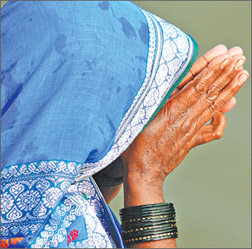
A Hindu praying |
I value this Hindu self-relativization in its quest for the ultimate,
the awareness of the risk that epistemology may forever fall short of
ontology. I think it salutary to be cautious in this way in terms of
metaphysics.
The West displays a tendency in the moral realm to speak in
absolutes. An absolute is fixed; it allows of no exceptions. Stated in a
positive way, one could say that an absolute is certain and firm; stated
in a negative way, one could say that it is static and rigid.
On the other hand, a universal is consensual and fluid. Stated in a
positive way, one could say that it is broad-based and dynamic; stated
in a negative way, one could say that it is wishy-washy and unsteady.
The differences between the two lie in their orientation – one works
from top down, the other from bottom up.
I think Hinduism is better off for implicitly distinguishing between
final and ultimate, and between absolute and universal, and in further
distinguishing between the goals of metaphysics and morality.
n A third distinction implicit in Hinduism is one between
single-mindedness and narrow-mindedness. Sometimes other religions, in
trying to become single-minded, become narrow-minded, as in certain
understandings of jihad in the context of terrorism, and of the
Christian mission in the context of proselytization.
I think the Hindu world has largely escaped this predicament, at
least so far, because Hinduism is a religion which has its center
everywhere and its circumference nowhere, in the sense that the doctrine
of the ishtadevata (or the chosen Deity) within it allows each Hindu to
be a center of his or her own universe or to be single-minded in his or
her devotion without being judgmental about others.
Alternatively, Hinduism can be said to have its circumference
everywhere and its center nowhere.
However, we might wish to split the metaphor. By disconnecting the
center from the circumference, it has ensured that being single-minded
does not lead to narrow-mindedness in relation to another. This is true
not just for Hinduism’s individual members but also of the yogas within
it.
For example, one can single-mindedly follow a particular yoga, such
as jnana, without narrow-mindedly insisting that it is the only yoga
which will lead to liberation.
True, some texts will say precisely this, but other texts will say
precisely the same about other yogas. And Hindu sages periodically
remind the flock that the four margas, karma, bhakti, yoga and jnana,
are not exclusive of one another.
n A fourth distinction implicit within Hinduism is that between sole
and unique. When we use the word unique, we tend to assimilate the sense
of sole into it, for unique means that which stands by itself. But the
two should not be confused, according to Hinduism.
Some Western religious traditions tend to confuse them, and because
they are unique, tend to look upon themselves as the sole avenue to the
divine. But each tradition is unique. In fact, each human being is
unique. Does that entitle him or her to look upon oneself as the sole
human being?
n Another distinction implicit within Hinduism is between one and
only. Often in introducing an outstanding person, such as the actor
Amitabh Bachchan, we might employ the phrase “the one and only”
so-and-so. But there is a difference between one God, and only God. When
we say there is only one God we mean to say that there is no other God,
but when we say there is only God we mean that there is nothing else in
reality apart from God.
In technical terms, these interpretations can be called monotheistic
and pantheistic. But whereas the relationship between one and only is
used in Abrahamic religions to uphold their own monotheism and dismiss
that of others, the same relationship is used in Hinduism to embrace all
other Gods, as there is only God, who can be grasped and represented
variously.
Hinduism also adds that God is not just contained by the world but
rather contains it, and also transcends it, thereby leaving room for
what is called ‘panentheism.’
n Another distinction implicit in Hinduism is the distinction between
common and identical. Many of us here in the audience are married.
Marriage is thus a common phenomenon. But are all marriages identical?
It is important to make this point because Hinduism is accused of saying
that all religions are the same, as if their distinctive features did
not matter. This is a misrepresentation. All the religions are the
common property of humanity, but this is not to say that they are
identical.
n Another distinction implicit in Hinduism is between origin and
cause. Hinduism is said to be reckless in borrowing from others on the
one hand, and shameless in suppressing this fact on the other. But note
that those who are exercised by the question “Who borrowed from whom?”
are concerned with origins.
But once you are concerned with cause rather than origin, you are not
so much concerned with where something comes from as with how well it
explains something, irrespective of where it comes from. If I catch the
flu, its origin may lie in the person I caught it from, but its cause is
viral infection. Note that causes are universal in comparison to
origins, which are particular.
What makes it particularly exciting to be a Hindu in our times is the
fact that these implicit assumptions of Hinduism are being forced out as
explicit propositions as Hinduism confronts other religions. As this
happens, our Hindu principles shed a flood of light on the religious
predicament of the contemporary world.
Some scholars in the academia maintain that there is no such thing as
Hinduism. A Hindu attempt to tackle this view reveals another subtle
aspect of Hinduism. The phenomenon of deep sleep provides a good example
here. One is said to be unconscious in sleep, but it has been argued by
Sankara that sleep is really a state which represents the absence of
anything experienced separate from consciousness, rather than the
absence of consciousness itself.
Similarly, when a Hindu says that all religions are the same as
Hinduism, it indicates the absence of any of them being experienced as
separate from Hinduism, rather than the absence of Hinduism itself. This
is Hinduism’s answer to the fashionably current view that there is no
such thing as Hinduism.
Hinduism Today
To be continued
Arulmigu Sri Venkateshwara Temple:
Chariot Festival and water cutting ceremony
Thereafter Arjuna started fighting and won the battle. In fact,
this is the crux of the Bhagavad Geetha. Further, in the Mahabharatha
battle he protected Pandavas from Duryodana. He even went as an
Ambassador to Duryodana’s palace for the sake of Pandavas
Chelvatamby MANICCAVASAGAR
Arulmigu Sri Venkateshwara Mahavishnu Temple which is dedicated to
Lord Krishna is situated at Mutwal, Colombo-15. The annual festival of
this temple commenced with the hoisting of the flag and will conclude
with the water cutting ceremony today in the nearby sea. The trustees of
this temple have made elaborate arrangements for the progress and
success of this festival.
According to historians, 3,000 years before the birth of Jesus
Christ, Sri Krishna took a Divine birth in the Indian city of Madurai.
Scriptures call him ‘Purna Avathara’, that is the full manifestation of
God, Lord Krishna was a teacher and lover of mankind.
|
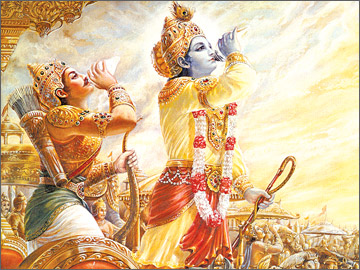
Lord Krishna and Arjuna at Kurukshetra |
He is most accessible to the pure hearted who have cultivated true
love for him. The simple, rustic cowherd boys and girls took liberties
with Sri Krishna who enjoyed his sport in their company.
Sri Krishna is the greatest Karma Yogi of all time. His immortal
teachings on Karma Yoga, Bhakthi Yoga and Gnana Yoga have no parallel in
religious literature.
The Bhagavat Purana, the Vishnu Purana and Mahabharatha proclaim that
there was none to match Sri Krishna in beauty, wisdom and perfection.
His enchanting form with flute in one hand is worshipped by millions in
India and Sri Lanka.
Every word of his teachings and every act of his life is full of
substance. In the Mahabharatha battle he was the charioteer to Arjuna.
When Arjuna went to the battleground to fight with his cousins
Duryodana, Karnan, Bhismar and several others, he was reluctant to fight
and put down the bow and arrow on the ground when he saw all his
relations. Indeed, he was in utter misery and did not know what to do.
At this stage, “Lord Vishnu taught him the Bhagavad Geetha.”
According to the Bhagavad Geetha this world is a battleground. No doubt,
there will be problems like waves in the sea. As such, one should not
run away from problems and we have to face the problems without getting
disturbed and have to act in a spirit of detachment.
Lord Vishnu told Arjuna, “You have come to fight and your duty is to
fight and don’t be reluctant. Thereafter Arjuna started fighting and won
the battle. In fact, this is the crux of the Bhagavad Geetha.
Further, in the Mahabharatha battle he protected Pandavas from
Duryodana. He even went as an Ambassador to Duryodana’s palace for the
sake of Pandavas.
Indeed, Lord Vishnu is considered to be the preserver of the
universe, the embodiment of the qualities of mercy and goodness. As the
preserver of the universe, Lord Vishnu is the object of devotion and he
descended to the earth as a great hero to save mankind and to maintain
Dharma.
Lord Vishnu, with the view to preserve Dharma and to destroy wicked
from their atrocities and dehumanizing and emasculating fear created by
Asuras took ten incarnations to protect his devotees.
His first incarnation was in the form of a Gold Fish, the second as a
Tortoise, third as a Boar, fourth in the form of Narasinha and in the
fifth incarnation Lord Vishnu was Vamana, in the sixth he was born as
Parasuram, seventh he was born as Balaraman, eighth he was born as Rama
and his ninth incarnation was Lord Krishna to destroy the wicked demons
and to take the leading part in the great war fought in the battlefield
Kurushetra where he delivered his wonderful message of the Bhagavad
Geetha.
Sri Venkateshwara Maha Vishnu Temple is the only temple situated in a
place of peacefulness and purity and is in close proximity to the sea at
Mutwal and the devotees perform this religious rites since this temple
has an excellent view of the river embracing the mighty Indian Ocean, in
Mutwal.
During the Ther or Chariot festival the statue of Lord Vishnu is
decorated and illuminated and taken along the streets in a chariot
followed by Poojas and Bhajans accompanied by Nathaswara music and the
water cutting ceremony will take place at the Indian Ocean which is
close to the temple.
|
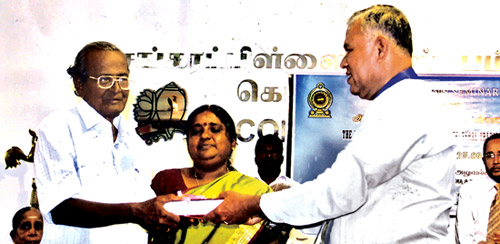
A religious book titled ‘The Vijayanagar Empire and cultural
renaisance’ published by the Hindu Religious and Cultural
Affairs Dept. was released at the Colombo Tamil Sangam
Wellawatta, Colombo 6 last month. Here the maiden copy is
being presented by the Buddhasasana and Religious Affairs,
Deputy Minister M K A D S Gunawardana to Professor V
Sivasamy while Department Directress Shanthi Naukkarasan
looks on. |
|
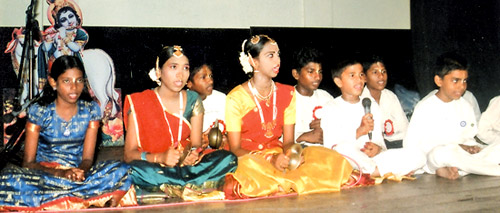
A cultural dance program of the Hare Rama Krishna Bakthi
Kasagam, Colombo branch affiliated to the International
Krishna Bakthi Kasagam took place at the Pradeepa Hall,
Maligawatta, Colombo 10. The event was organised to mark its
10 year anniversary. Here a Bajan Recital is presented by
the students. |
|
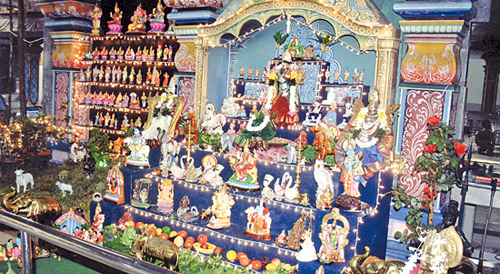
The Navarathiri festival was celebrated at Kovils, schools
and houses. Poojas were held on all nine days with the
displaying of statues and deities “Kolu”. Here a Kolu
displaying at the Sri Venkateswarar Maha Vishnu Kovil,
Modera, Colombo 15. |
|
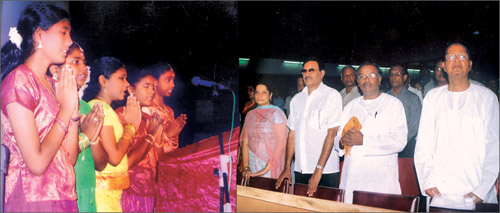
A group of students of, ‘Aum Cria Babaji Yoga Aranyam’
religious school sing ‘Thevaram’ (Religious Prayers) at
their 2nd Anniversary Ceremony, held at the Ramakrishna
Mission Hall, Wellawatta, Colombo 6 recently. A section of
the gathering also seen here. |
|

The annual “Ther” chariot festival of the Sri Sarvartha
Sithi Vinayagar Kovil, Modera, Colombo 15, took place
recently. Here the colourfully decorated ‘Ther’ chariot is
being taken in procession with the Natheswara music group. |
|

The dance recital and souvenir launch of the Hare Rama Hare
Krishna Bakthi Kazhagam Kotahena Affiliated to the
International Krishna Bakthi Kazhagam was held at the
Pradeepa Hall, Maligawatta, Colombo 10 recently. Here
President of the Kazhagam, Maha Karthadas performing the
special pooja to Lord Krishna before commencing the
ceremony. A dance item also in the picture. Pictures by A.
Maduraveeran |
|



